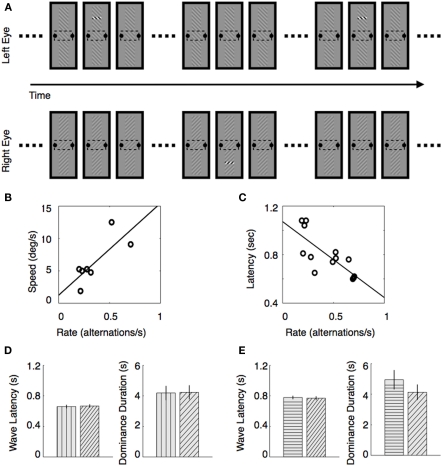Figure 3.
Relation between traveling wave dynamics and dominance durations accompanied with spontaneous perceptual alternations. (A) Stimulus conditions that implement the periodic perturbation technique. While observers are reporting perceptual alternations within the monitoring region during an extended viewing period of binocular rivalry, triggers are presented periodically in antiphase. A trigger comprises a brief contrast increment within a small region of rival figure. Trigger locations are different for the two rival stimuli: one is presented at the upper region and the other one is presented at the lower region of the two rival stimuli, respectively. (B,C) Traveling wave speed covaries with alternation rate. (B) Estimated traveling wave speed of each observer is plotted as a function of alternation rate. (C) Estimated traveling wave for each observer is plotted as a function of alternation rate. (D,E) Latency of the traveling waves and dominance durations when rival stimuli of different collinearity are presented. (D) Result when the vertical and diagonal gratings are presented: mean latency (Left) and mean dominance duration (Right). Pattern filled within the bar indicates the stimulus pattern either carrying traveling waves that emerges from suppression (Left) or being associated with perceptual dominance (Right). (E) Result when the horizontal and diagonal gratings are presented. These figures are reproduced from Kang (2009), Kang et al. (2010), with permission from Journal of Vision.

